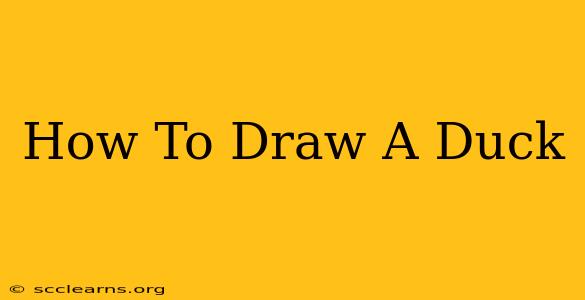So you want to learn how to draw a duck? Whether you're a seasoned artist looking for a new challenge or a complete beginner picking up a pencil for the first time, this guide will walk you through the process step-by-step. We'll cover everything from basic shapes to adding fine details, ensuring you create a quacking good drawing!
Getting Started: Essential Materials
Before we dive into the drawing process, let's gather the necessary materials. You don't need anything fancy – just a few essentials will do:
- Paper: Any drawing paper will work, but thicker paper is preferable to prevent bleed-through, especially if you're using watercolors or markers later on.
- Pencil: A standard HB pencil is perfect for sketching. You might also want a softer pencil (like a 2B) for shading.
- Eraser: A good eraser is crucial for correcting mistakes. A kneaded eraser is especially helpful for lifting small amounts of graphite.
- Sharpener: Keep your pencils sharp for clean lines.
Step-by-Step Duck Drawing Tutorial
Now for the fun part! Let's learn how to draw a duck in simple stages.
Step 1: The Basic Shapes
Start by sketching a large oval for the duck's body. Then, add a smaller circle overlapping the oval slightly – this will be the duck's head.
Step 2: Defining the Head and Body
Connect the head and body with a smooth curve. Refine the shapes, making the body more elongated and the head more rounded. Don't worry about making it perfect at this stage; this is just a guide.
Step 3: Adding the Beak
Draw a triangle shape for the duck's beak, attaching it to the bottom of the head. Add a slight curve to make it look more realistic.
Step 4: The Eyes and Feet
Add two small circles for the eyes, placing them on either side of the beak. For the feet, draw two simple triangles pointing downwards, slightly overlapping the bottom of the body.
Step 5: Tail and Wings
Sketch a short, slightly curved line at the back of the body for the tail. For the wings, draw two slightly curved lines extending from the sides of the body.
Step 6: Refining the Details
Now it's time to add some detail! Refine the shapes of the beak, eyes, and feet. You can add some feathers by adding short, curved lines along the body and wings.
Step 7: Adding Texture and Shading
Use shading to give your duck a three-dimensional look. Add darker shading under the beak and chin, and along the edges of the body and wings to create depth. Experiment with different shading techniques to add texture to the feathers.
Different Duck Breeds: Adding Variety
Once you've mastered the basics, try drawing different types of ducks! Mallards have distinctive green heads, while Pekin ducks are all white. Experiment with different beak shapes, body proportions, and feather patterns to create unique and interesting duck drawings.
Beyond the Basics: Advanced Techniques
For those looking to elevate their duck drawings, consider exploring these advanced techniques:
- Perspective: Learn how to draw ducks in different perspectives to add realism and depth to your artwork.
- Watercolor/Colored Pencils: Add color to your drawings using watercolors, colored pencils, or other mediums.
- Reference Images: Use reference images of real ducks to help you accurately capture their features.
Practice Makes Perfect!
Drawing ducks, like any skill, requires practice. Don't be discouraged if your first attempt isn't perfect. The more you draw, the better you'll become. So grab your pencils, and keep practicing! You'll be creating amazing duck drawings in no time. Happy drawing!

